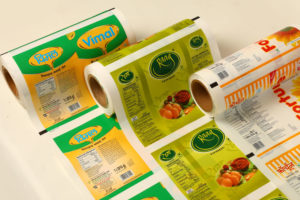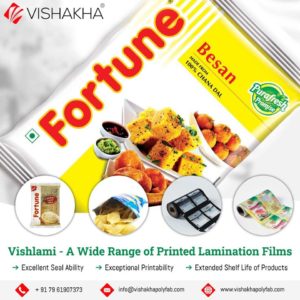Lamination adhesives are widely applied in the flexible packaging industry and are ideal for busy packaging environments. Their design, layers, chemical properties, film strength, type of adhesive and bonding methods play an imperative role in achieving unique packaging characteristics.
The performance of a laminated film adhesive depends on the mechanical properties, ability to prevent moisture and gas entry, ease of sealing, printability and cost. They may be rigid of flexible.

Production Techniques
To produce the suitable package, a thin layer of plastic materials is extruded and then bonded to another layer of dissimilar material. Different materials are selected so as to match various packaging properties. For example one layer may be selected to provide high mechanical strength while the other layer may provide great barrier and sealing properties. These materials are then bonded using an adhesive. The co-extrusion process may involve many layers being extruded and bonded together. The main production techniques involve dry bonding, wet bonding, ultraviolet curing and thermal adhesion process.
Laminating Adhesives and Applications
The laminating adhesive plays an imperative role in bonding the laminates. In addition to its bonding ability, the adhesive must have other superior characteristics such as chemical (mixing ratio, shelf life and curing time), physical (density, molecular weight, viscosity drying speed and wetting behavior) and performance (bonding strength, resistance to environmental process, and resistance to corrosion, adaptability and laminating conditions).
Suitability for Different Packaging Materials
Laminated film is suitable for different packaging processes. By adding different coextruded layers, it is possible to alter the film properties such as decreased gas/ oxygen permeability, puncture resistant, resistance to heat, water and solvent proofing, superior optical properties, electrical insulation or conductivity, anti fog properties and ability to resist oil as well as chemical attack.

3 Layer Co-Extruded Lamination Films
These are low strength films with have three layers of 2 or 3 dissimilar materials bonded using different configurations. For two materials the arrangement can be A\B\A or A\A\B depending on use. Lamination Films are cheaper and provide adequate packaging for food, shampoos, snacks, detergents and edible oils.
5 Layer Co-Extruded Lamination Films
These are medium strength laminates that use special adhesives to increase strength. They are applied in packaging chemicals, soap, industrial products, medical and pharmaceutical products and hot filling juices. They comprise of five different layers of brown extrusions that are joined using adhesives. They can be EVOH based 5 layer films. They are used to create barrier from water, gas, aroma and flavor. They are resistance to chemicals, cracks, UV and are easily printable. They are also used in packaging reactive materials such as fruits and meat this can discolor the package. Since some film prevent aroma loss, the film can be used to pack spices, juice, toothpaste and juice. Special films also allow packaging of pesticide and fungicides.
7 And 9 Layer Co-Extruded Lamination Films
7 and 9 layers films offer extensive advantages and replace aluminum packaging which is expensive. The different layers provide great sealing and properties such as oxygen, gas and carbon dioxide barrier; transparency, odors, high strength; easy printability, water proofing among others. They are used for packaging refrigerated products such as meat, poultry, cheese and unrefrigerated products such as powder milk, nuts, pet food and wine.
